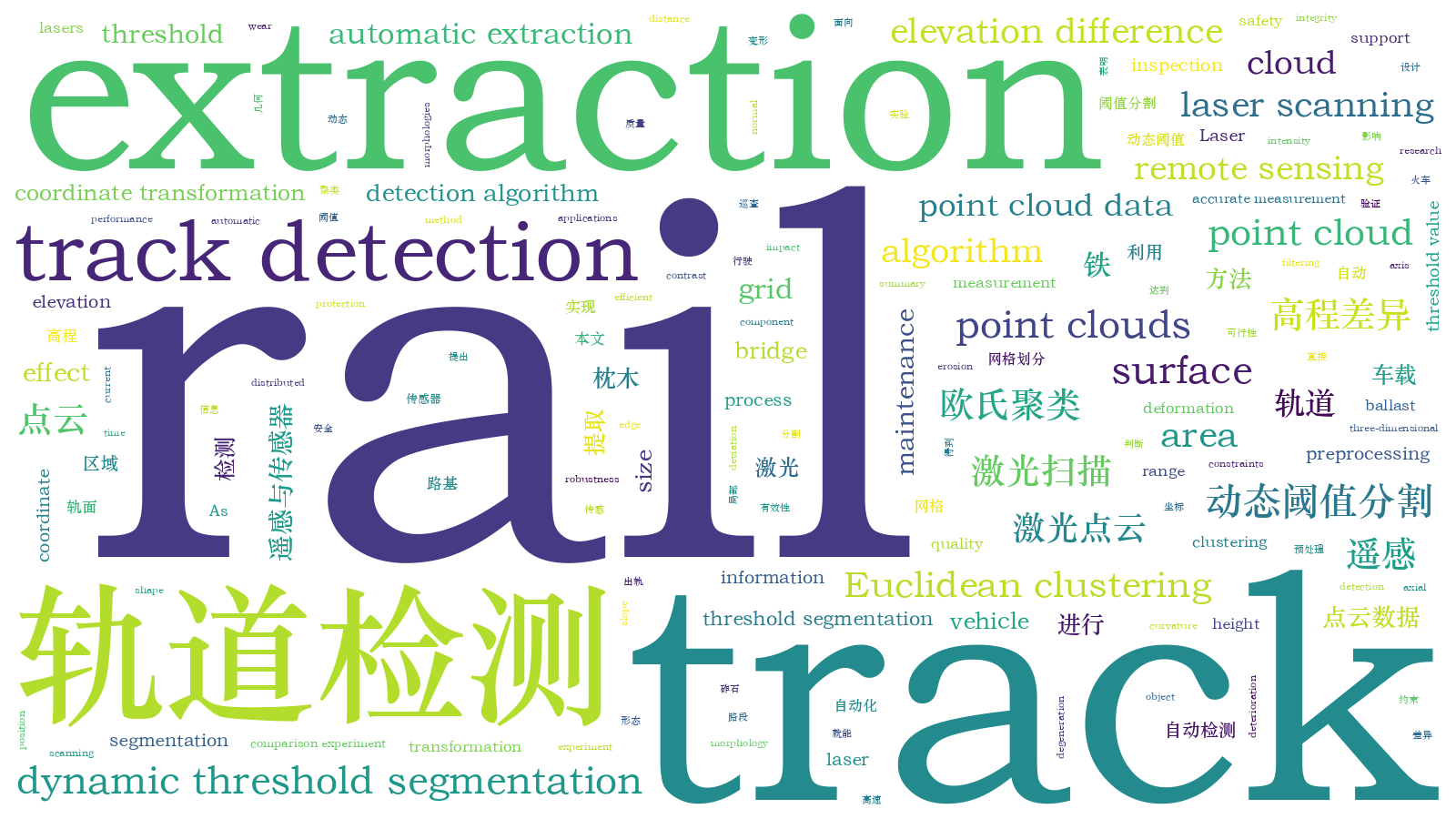基于车载激光点云的铁路轨道检测  下载: 824次
下载: 824次
Because rail transportation is an important part of our country’s transportation, track maintenance is essential. On the one hand, the safety hazard will be caused by the degeneration and deformation of track component performance due to cyclical loads and natural erosion. Among them, the wear, deformation, rust, peeling, and falling of the rail surface are the main problems of the track. As a result, the most important aspect of the maintenance work is the inspection of the rail surface. Furthermore, the deterioration of track sleepers and the introduction of foreign objects above the sleepers all have an impact on the train’s safety. Track inspection can also provide data support for track maintenance by determining whether its working status is normal or not based on the integrity of the sleeper point clouds. On the other hand, vehicle-mounted lasers are widely used in the field of track inspection and have good measurement effects on three-dimensional objects. In summary, we propose an automated algorithm based on the vehicle-mounted laser track point cloud that realizes point cloud preprocessing and automatic extraction of rail surface point clouds using only the point cloud coordinate information. As a result, the sleeper point clouds serve as data support for track maintenance.
Concerning preprocessing of point cloud data, based on the flat morphology of the track bed area, the track bed area was extracted by Euclidean clustering with height constraints. The rail was the only object with elevation jumps in the track bed area when it came to rail surface extraction. To begin, the subgrade area was griddled. The point cloud in each grid was then evaluated for elevation, and the grid that met the rail’s height jump was extracted and merged to form a rough-extracted rail point cloud. Finally, coordinate transformation, clustering, filtering, and other operations were used to achieve refined rail surface extraction. In terms of sleeper extraction, there were clear geometric differences between sleeper point clouds and ballast point clouds. First, the track area was extracted from the subgrade area using the rail surface’s position information. Second, using coordinate transformation, the track was distributed along the axial direction. Finally, the track was segmented, and the sleeper point clouds were extracted by comparing the morphologies of the sleepers and the ballast.
It can be seen from Table 1 that the optimal grid size range is 0.080.1 m. If the grid size is too large, the slope protection area will be mistaken for the rail extraction, resulting in erroneous extraction; too small, the middle area of the rail will be missed, resulting in incomplete extraction. The reason for this is that the rail on the side of the rail blind area does not meet the elevation judgment conditions due to the shape of the rail and the scanning blind area on the side of the rail that is scanned by the vehicle-mounted laser. Table 2 shows that the rail surface extraction effect of this algorithm is slightly better than that of Yang’s algorithm in the comparison experiment. At the same time, the curvature threshold of the comparison algorithm is difficult to determine, and the extraction process requires intensity information, so the rail surface extraction algorithm in this paper has a certain research value. The optimal basic thresholds for bridge areas and non-bridge areas are 0.25 m and 0.28 m, respectively, as shown in Tables 3 and 4. The basic threshold represents the vertical distance from the lower edge of the current sleeper to the rail surface. Due to the difference in the laying methods of the sleepers in the two types of areas, there is a 3 cm deviation in the optimal basic threshold between the two areas.
Based on a vehicle-mounted laser track point cloud, this paper develops a rail surface and sleeper detection algorithm. Multiple sets of different grid size comparison experiments are carried out in the process of extracting the rail surface, based on rail data in different regions, and the optimal grid size range is 0.080.1 m. The effect is shown in Fig. 6. On this basis, in contrast with the method proposed by Yang, the rail surface extraction effect of this algorithm is slightly better than that of Yang’s algorithm, and the robustness is better. The extraction quality averages 97.8% and 96.3%, respectively. Several different basic threshold segmentation experiments are carried out during the extraction process to extract sleepers for different areas. In bridge areas and non-bridge areas, the optimal basic thresholds are 0.25 m and 0.28 m, respectively. The maximum value of the z-axis of the point cloud in each segment is used as the upper limit of segmentation, and the difference between it and the corresponding basic threshold value is used as the lower limit of segmentation, which has a better extraction effect. Fig. 7 depicts the effect. The extraction quality is 93.6%. In conclusion, the algorithm proposed in this paper is effective and feasible, has some practical applications, and can provide efficient and accurate measurement data for track maintenance.
李维刚, 梅洋, 樊响, 赵云涛. 基于车载激光点云的铁路轨道检测[J]. 中国激光, 2022, 49(4): 0410002. Weigang Li, Yang Mei, Xiang Fan, Yuntao Zhao. Railway Track Detection Based on Vehicle Laser Point Cloud[J]. Chinese Journal of Lasers, 2022, 49(4): 0410002.







